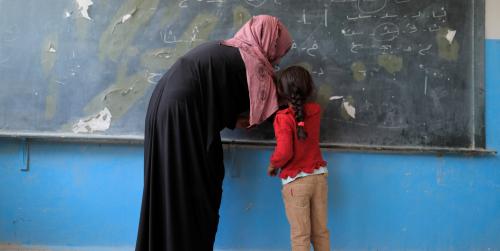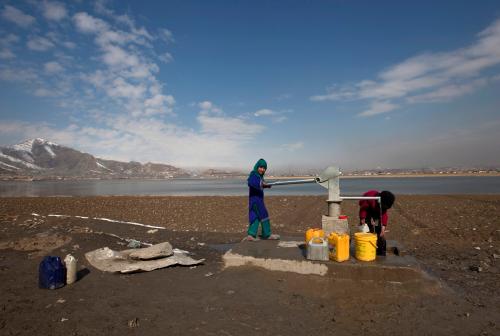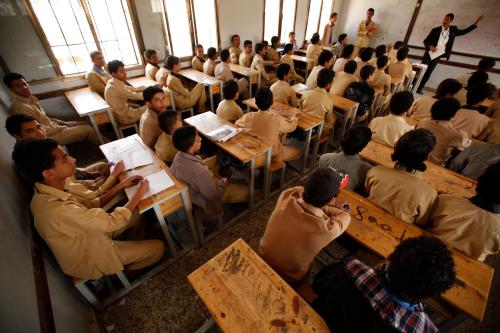The catastrophic wind and rain of Hurricane Dorian not only left thousands of people homeless but also children and adolescents without schools. The Bahamas is not alone; as global temperatures rise, climate scientists predict that more rain will fall in storms that will become wetter and more extreme, including hurricanes and cyclones around the world. An often overlooked result is the disruption of schooling, which threatens the physical safety and psychosocial well-being of students and teachers. The longer that school is shut down, the less likely it is that children will return. Moreover, research has shown a lower academic performance and a reduction in educational attainment among children who have experienced climate shocks. But, fortunately, the Bahamas and other countries can learn from work being undertaken in Nepal to keep learners safe by reducing disaster risk and increasing the resilience of the education sector to future climate risks.
Nepal is highly vulnerable to climate change, and has experienced changes in temperature and precipitation at a faster rate than the global average. Indeed, climate change is causing greater variation in weather patterns, and more extreme weather events in Nepal, like droughts that contribute to wildfires and monsoons that contribute to flooding. In 2017, for example, approximately 1.7 million people across southern Nepal were affected by monsoon floods, including 460,000 people who were displaced from their homes. At least 383 schools were used as shelters, and many were damaged, including the loss of teaching and learning materials, ultimately disrupting educational continuity. Nepal is also impacted by hazards such as earthquakes and man-made conflict, the latter a legacy of Nepal’s 10-year Maoist rebellion (1996 to 2006) where schools and children were directly targeted.
It was two earthquakes in 2015 that killed nearly 9,000 people, injured more than 22,000 others, and destroyed more than 35,000 classrooms. A wake-up call for Nepal about its vulnerable education infrastructure and limited capacity to mitigate the impact of large natural disasters. The earthquakes accelerated government-led efforts to develop a long-term plan to improve the safety of Nepal’s schools. The Ministry of Education and partners like UNICEF and international and national NGOs harnessed the opportunity offered by the crisis to build back better schools. They focused earthquake recovery on the construction of safe learning spaces with integrated child protection and psycho-social well-being and water, sanitation, and hygiene services, along with improvements in teaching and learning and school disaster management.
In 2016, Nepal’s School Sector Development Plan focused education policy and planning not only on strengthening equity, quality, efficiency and governance in the education sector, but also on resilience. The Plan’s disaster risk reduction objectives sought to ensure that all children could access safe learning environments and mainstream comprehensive school safety and disaster risk reduction in the education sector.
In 2017 the Ministry of Education developed a Master Plan for Comprehensive School Safety to mainstream school safety and risk reduction and resilience in the education sector. Using multi-hazard risk-informed analysis to integrate risk reduction, conflict sensitivity, and peacebuilding into education preparedness, humanitarian response, and school sector development, the three pillars of Nepal’s Comprehensive School Safety Master Plan are:
1. Resilient and safe schools that result from sound building locations and construction;
2. School disaster risk management, with school management committees and PTAs proactively working to reduce the vulnerability of schools and students through school disaster mapping and hazard simulations;
3. Resilience teaching and learning, whereby students learn new knowledge and skills about how to prepare for and respond to disasters in order to change behavior, manage risk and reduce vulnerability to hazards such as floods, earthquakes and violence, thereby building adaptive capacity.
The roadmap presented in the Master Plan is aimed at rapidly making Nepal’s schools and learning centers—and the students and teachers within them—resilient to disasters and the impacts of climate change, as well as to non-natural hazards, such as conflict. In effect, Nepal is institutionalizing risk reduction and resilience education so that children, teachers, and other education personnel can assess their environment for risks and quickly minimize human and education sector loss during disasters.
What is important for other countries to learn from Nepal is not only the comprehensive nature of its focus on resilience within the education sector—represented by the three different pillars of Nepal’s Comprehensive School Safety Master Plan—but also how partnerships within the country have supported this work. In a report on an “Agenda for Humanity,” the former U.N. Secretary-General proposed meeting people’s immediate humanitarian needs while simultaneously reducing risk and vulnerability. This “new way of working” focuses on the alignment of collective outcomes across the humanitarian and development communities—which often work in silos on the ground—impeding effectiveness of sustainable development efforts. In countless countries, there has been confusion among actors on what this looks like. In Nepal, the joint focus of humanitarian and coordination groups is realizing this “new way of working.” The Ministry of Education’s work in Nepal is a step toward reducing risk and vulnerability to the impacts of climate change by investing in preparedness and disaster risk reduction and strengthening response and resilience to future shocks.






Commentary
Building resilience in education to the impact of climate change
September 17, 2019